Exercising under COVID-2x: Conceptualizing Future Green Spaces in Australia’s Neighborhoods
Abstract
1. Introduction
2. The Effects of Lockdown in Communities in Australia and Beyond
3. Impact of Stay-at-Home Orders on People’s Ability to Exercise and Recreate
4. Utilization of Urban Green Spaces during the COVID-19 Pandemic
4.1. Types of Urban Green Spaces Utilised
4.2. The Australian Situation
5. Discussion
5.1. Planning Context
5.2. Temporary, ad-hoc Solutions
5.2.1. Provision of Pandemic-Sensitive Exercise Spaces
5.2.2. Provision of Pandemic-Sensitive Restorative Places
5.3. Long-Term Planning Adjustments
5.3.1. Spaces for Physical Exercise
5.3.2. Spaces for Mental Recreation
5.3.3. Conceptualizing ad-hoc Spaces for Mental Recreation
5.3.4. Communication Corridors
6. Outlook
Funding
Institutional Review Board Statement
Data Availability Statement
Conflicts of Interest
References
- WHO. Naming the Coronavirus Disease (COVID-19) and the Virus That Causes It. Available online: https://www.who.int/emergencies/diseases/novel-coronavirus-2019/technical-guidance/naming-the-coronavirus-disease-(covid-2019)-and-the-virus-that-causes-it (accessed on 10 August 2020).
- Ritchie, H.; Ortiz-Ospina, E.; Beltekian, D.; Mathieu, E.; Hasell, J.; Macdonald, B.; Giattino, C.; Roser, M. Coronavirus (COVID-19) Cases. Our World in Data. Available online: https://ourworldindata.org/covid-cases (accessed on 25 January 2021).
- Spreeuwenberg, P.; Kroneman, M.; Paget, J. Reassessing the global mortality burden of the 1918 influenza pandemic. Am. J. Epidemiol. 2018, 187, 2561–2567. [Google Scholar] [CrossRef]
- Ritchie, H.; Ortiz-Ospina, E.; Beltekian, D.; Mathieu, E.; Hasell, J.; Macdonald, B.; Giattino, C.; Appel, C.; Rodés-Guirao, L.; Roser, M. Coronavirus Pandemic (COVID-19). Available online: https://ourworldindata.org/coronavirus (accessed on 31 August 2021).
- Ye, Z.-W.; Yuan, S.; Yuen, K.-S.; Fung, S.-Y.; Chan, C.-P.; Jin, D.-Y. Zoonotic origins of human coronaviruses. Int. J. Biol. Sci. 2020, 16, 1686. [Google Scholar] [CrossRef] [PubMed]
- Wang, L.-F.; Anderson, D.E.; Mackenzie, J.S.; Merson, M.H. From Hendra to Wuhan: What has been learned in responding to emerging zoonotic viruses. Lancet 2020, 395, e33–e34. [Google Scholar] [CrossRef]
- Peeri, N.C.; Shrestha, N.; Rahman, M.S.; Zaki, R.; Tan, Z.; Bibi, S.; Baghbanzadeh, M.; Aghamohammadi, N.; Zhang, W.; Haque, U. The SARS, MERS and novel coronavirus (COVID-19) epidemics, the newest and biggest global health threats: What lessons have we learned? Int. J. Epidemiol. 2020, 49, 717–726. [Google Scholar] [CrossRef] [PubMed]
- Spennemann, D.H.R. Residential Architecture in a post-pandemic world: Implications of COVID-19 for new construction and for adapting heritage buildings. J. Green Build. 2021, 16, 199–215. [Google Scholar] [CrossRef]
- Kramer, A.; Kramer, K.Z. The potential impact of the Covid-19 pandemic on occupational status, work from home, and occupational mobility. J. Vocat. Behav. 2020, 119, 103442. [Google Scholar] [CrossRef]
- Musselwhite, C.; Avineri, E.; Susilo, Y. Editorial JTH 16–The Coronavirus Disease COVID-19 and implications for transport and health. J. Transp. Health 2020, 16, 100853. [Google Scholar] [CrossRef] [PubMed]
- Neuwirth, L.S.; Jović, S.; Mukherji, B.R. Reimagining higher education during and post-COVID-19: Challenges and opportunities. J. Adult Contin. Educ. 2020, 27, 141–156. [Google Scholar] [CrossRef]
- Spennemann, D.H.R.; Whitsed, R. The impact of COVID-19 on the Australian outdoor recreation industry from the perspective of practitioners. J. Outdoor Recreat. Tour. 2021, in press. [Google Scholar] [CrossRef]
- Haywood, K.M. A post-COVID future: Tourism community re-imagined and enabled. Tour. Geogr. 2020, 22, 599–609. [Google Scholar] [CrossRef]
- Bereitschaft, B.; Scheller, D. How Might the COVID-19 Pandemic Affect 21st Century Urban Design, Planning, and Development? Urban Sci. 2020, 4, 56. [Google Scholar] [CrossRef]
- Spennemann, D.H.R. Preparing for COVID-2x: Urban planning needs to regard urological wastewater as an invaluable communal public health asset and not as a burden. Urban Des. 2021, 5, 75. [Google Scholar] [CrossRef]
- Honey-Rosés, J.; Anguelovski, I.; Chireh, V.K.; Daher, C.; Konijnendijk van den Bosch, C.; Litt, J.S.; Mawani, V.; McCall, M.K.; Orellana, A.; Oscilowicz, E. The impact of COVID-19 on public space: An early review of the emerging questions–design, perceptions and inequities. Cities Health 2020, 1–17. [Google Scholar] [CrossRef]
- Moloney, K.; Moloney, S. Australian Quarantine Policy: From centralization to coordination with mid-Pandemic COVID-19 shifts. Public Adm. Rev. 2020, 80, 671–682. [Google Scholar] [CrossRef] [PubMed]
- Chinazzi, M.; Davis, J.T.; Ajelli, M.; Gioannini, C.; Litvinova, M.; Merler, S.; Piontti, A.P.y.; Mu, K.; Rossi, L.; Sun, K. The effect of travel restrictions on the spread of the 2019 novel coronavirus (COVID-19) outbreak. Science 2020, 368, 395–400. [Google Scholar] [CrossRef] [PubMed]
- Askitas, N.; Tatsiramos, K.; Verheyden, B. Lockdown strategies, mobility patterns and COVID-19. arXiv Preprint 2020, arXiv:2006.00531. [Google Scholar]
- Shakespeare-Finch, J.; Bowen-Salter, H.; Cashin, M.; Badawi, A.; Wells, R.; Rosenbaum, S.; Steel, Z. COVID-19: An Australian Perspective. J. Loss Trauma 2020, 25, 662–672. [Google Scholar] [CrossRef]
- Woskie, L.R.; Wenham, C. Do men and women lockdown differently? An examination of Panama’s COVID-19 sex-segregated social distancing policy. medRxiv 2020. [Google Scholar] [CrossRef]
- Kanbur, N.; Akgül, S. Quaranteenagers: A Single Country Pandemic Curfew Targeting Adolescents in Turkey. J. Adolesc. Health 2020, 67, 292. [Google Scholar] [CrossRef]
- Spennemann, D.H.R. “No Entry into New South Wales”: COVID-19 and the Historic and Contemporary Trajectories of the Effects of Border Closures on an Australian Cross-Border Community. Land 2021, 10, 610. [Google Scholar] [CrossRef]
- MHMR. Public Health (COVID-19 Restrictions on Gathering and Movement) Order 2020 (30 March 2020). New South Wales Gov. Gaz. 2020, 65, 1149–1163. [Google Scholar]
- MHMR. Public Health (COVID-19 Greater Sydney) Order 2021. N. S. W. Gov. Gaz. 2021, 178, 1–8. [Google Scholar]
- MHMR. Public Health (COVID-19 Greater Sydney) Order (No 2) 2021. N. S. W. Gov. Gaz. 2021, 266, 1–13. [Google Scholar]
- MHMR. Public Health (COVID-19 Additional Restrictions for Delta Outbreak) Amendment (No 27) Order 2021. N. S. W. Gov. Gaz. 2021, 369, 1–6. [Google Scholar]
- MHMR. Public Health (COVID-19 Temporary Movement and Gathering Restrictions) Order 2021. N. S. W. Gov. Gaz. 2021, 282, 1–17. [Google Scholar]
- Spennemann, D.H.R. COVID face masks: Policy shift results in increased littering. Sustainability 2021, 13, 9875. [Google Scholar] [CrossRef]
- Spennemann, D.H.R. Facing COVID-19: Quantifying the use of reusable vs. disposable facemasks. Hygiene 2021, 1, 120–128. [Google Scholar] [CrossRef]
- Mackenzie, S.H.; Goodnow, J. Adventure in the age of COVID-19: Embracing microadventures and locavism in a post-pandemic world. Leis. Sci. 2020, 43, 62–69. [Google Scholar] [CrossRef]
- Rice, W.L.; Mateer, T.; Taff, B.D.; Lawhon, B.; Reigner, N.; Newman, P. Longitudinal changes in the outdoor recreation community’s reaction to the COVID-19 pandemic: Final report on a three-phase national survey of outdoor enthusiasts. SocArXiv 2020. [Google Scholar] [CrossRef]
- Rice, W.L.; Mateer, T.J.; Taff, B.D.; Lawhon, B.; Newman, P. Continued longitudinal analysis of avid outdoor recreationists during the COVID-19 pandemic and sensitivities to new outdoor recreationists. SocArXiv 2021. [Google Scholar] [CrossRef]
- O’Connell, T.S.; Howard, R.A.; Hutson, G. The Impact of COVID-19 on Outdoor Recreation Participation in Canada; Brock University: St. Catharines, ON, Canada, 2020. [Google Scholar]
- Douglas, M.; Katikireddi, S.V.; Taulbut, M.; McKee, M.; McCartney, G. Mitigating the wider health effects of covid-19 pandemic response. BMJ 2020, 369, m1557. [Google Scholar] [CrossRef]
- Grant, R.; Gorman-Murray, A.; Briohny Walker, B. The Spatial Impacts of COVID-19 restrictions on LGBTIQ wellbeing, visibility, and belonging in Tasmania, Australia. J. Homosex. 2021, 68, 647–662. [Google Scholar] [CrossRef] [PubMed]
- Bil, J.S.; Buława, B.; Świerzawski, J. Mental Health and the City in the Post-COVID-19 Era. Sustainability 2021, 13, 7533. [Google Scholar] [CrossRef]
- Pouso, S.; Borja, Á.; Fleming, L.E.; Gómez-Baggethun, E.; White, M.P.; Uyarra, M.C. Contact with blue-green spaces during the COVID-19 pandemic lockdown beneficial for mental health. Sci. Total Environ. 2021, 756, 143984. [Google Scholar] [CrossRef] [PubMed]
- Heo, S.; Desai, M.U.; Lowe, S.R.; Bell, M.L. Impact of Changed Use of Greenspace during COVID-19 Pandemic on Depression and Anxiety. Int. J. Environ. Res. Public Health 2021, 18, 5842. [Google Scholar] [CrossRef]
- Ettman, C.K.; Abdalla, S.M.; Cohen, G.H.; Sampson, L.; Vivier, P.M.; Galea, S. Prevalence of Depression Symptoms in US Adults Before and During the COVID-19 Pandemic. JAMA Netw. Open 2020, 3, e2019686. [Google Scholar] [CrossRef] [PubMed]
- Geary, R.S.; Wheeler, B.; Lovell, R.; Jepson, R.; Hunter, R.; Rodgers, S. A call to action: Improving urban green spaces to reduce health inequalities exacerbated by COVID-19. Prev. Med. 2021, 145, 106425. [Google Scholar] [CrossRef] [PubMed]
- Alizadehtazi, B.; Tangtrakul, K.; Woerdeman, S.; Gussenhoven, A.; Mostafavi, N.; Montalto, F.A. Urban Park Usage During the COVID-19 Pandemic. J. Extrem. Events 2020, 7, 2150008. [Google Scholar] [CrossRef]
- Uchiyama, Y.; Kohsaka, R. Access and use of green areas during the covid-19 pandemic: Green infrastructure management in the “new normal”. Sustainability 2020, 12, 9842. [Google Scholar] [CrossRef]
- Storen, R.; Corrigan, N. COVID-19: A chronology of state and territory government announcements (up until 30 June 2020). In Parliamentary Library Research Paper Series 2020–21; Parliamentary Library, Commonwealth of Australia: Canberra, Australia, 2020. [Google Scholar]
- Fearnbach, S.N.; Flanagan, E.W.; Höchsmann, C.; Beyl, R.A.; Altazan, A.D.; Martin, C.K.; Redman, L.M. Factors Protecting against a Decline in Physical Activity during the COVID-19 Pandemic. Med. Sci. Sports Exerc. 2021, 53, 1391–1399. [Google Scholar] [CrossRef]
- Cugusi, L.; Di Blasio, A.; Bergamin, M. The social media gym-class: Another lesson learnt from COVID-19 lockdown. Sport Sci. Health 2021, 17, 487–488. [Google Scholar] [CrossRef]
- Meiring, R.M.; Gusso, S.; McCullough, E.; Bradnam, L. The effect of the COVID-19 pandemic movement restrictions on self-reported physical activity and health in New Zealand: A cross-sectional survey. Int. J. Environ. Res. Public Health 2021, 18, 1719. [Google Scholar] [CrossRef] [PubMed]
- Nyenhuis, S.M.; Greiwe, J.; Zeiger, J.S.; Nanda, A.; Cooke, A. Exercise and fitness in the age of social distancing during the COVID-19 pandemic. J. Allergy Clin. Immunol. Pract. 2020, 8, 2152. [Google Scholar] [CrossRef]
- Hartig, T.; Mitchell, R.; de Vries, S.; Frumkin, H. Nature and Health. Annu. Rev. Public Health 2014, 35, 207–228. [Google Scholar] [CrossRef]
- van den Bosch, M.; Ode Sang, Å. Urban natural environments as nature-based solutions for improved public health—A systematic review of reviews. Environ. Res. 2017, 158, 373–384. [Google Scholar] [CrossRef] [PubMed]
- Triguero-Mas, M.; Dadvand, P.; Cirach, M.; Martínez, D.; Medina, A.; Mompart, A.; Basagaña, X.; Gražulevičienė, R.; Nieuwenhuijsen, M.J. Natural outdoor environments and mental and physical health: Relationships and mechanisms. Environ. Int. 2015, 77, 35–41. [Google Scholar] [CrossRef]
- Taylor, M.S.; Wheeler, B.W.; White, M.P.; Economou, T.; Osborne, N.J. Research note: Urban street tree density and antidepressant prescription rates—A cross-sectional study in London, UK. Landsc. Urban Plan. 2015, 136, 174–179. [Google Scholar] [CrossRef]
- Van Dillen, S.M.; de Vries, S.; Groenewegen, P.P.; Spreeuwenberg, P. Greenspace in urban neighbourhoods and residents’ health: Adding quality to quantity. J. Epidemiol. Community Health 2012, 66, e8. [Google Scholar] [CrossRef] [PubMed]
- Lopez, B.; Kennedy, C.; McPhearson, T. Parks are Critical Urban Infrastructure: Perception and Use of Urban Green Spaces in NYC During COVID-19. Preprints 2020, 2020080620. [Google Scholar] [CrossRef]
- Noël, C.; Rodriguez-Loureiro, L.; Vanroelen, C.; Gadeyne, S. Perceived health impact and usage of public green spaces in Brussels’ metropolitan area during the COVID-19 epidemic. Front. Sustain. Cities 2021, 3, 30. [Google Scholar] [CrossRef]
- Xie, J.; Luo, S.; Furuya, K.; Sun, D. Urban Parks as Green Buffers During the COVID-19 Pandemic. Sustainability 2020, 12, 6751. [Google Scholar] [CrossRef]
- Venter, Z.S.; Barton, D.N.; Gundersen, V.; Figari, H.; Nowell, M.S. Back to nature: Norwegians sustain increased recreational use of urban green space months after the COVID-19 outbreak. Landsc. Urban Plan. 2021, 214, 104175. [Google Scholar] [CrossRef]
- Geng, D.C.; Innes, J.; Wu, W.; Wang, G. Impacts of COVID-19 pandemic on urban park visitation: A global analysis. J. For. Res. 2021, 32, 553–567. [Google Scholar] [CrossRef]
- Grima, N.; Corcoran, W.; Hill-James, C.; Langton, B.; Sommer, H.; Fisher, B. The importance of urban natural areas and urban ecosystem services during the COVID-19 pandemic. PLoS ONE 2020, 15, e0243344. [Google Scholar] [CrossRef] [PubMed]
- Volenec, Z.M.; Abraham, J.O.; Becker, A.D.; Dobson, A.P. Public parks and the pandemic: How park usage has been affected by COVID-19 policies. PLoS ONE 2021, 16, e0251799. [Google Scholar] [CrossRef]
- Ugolini, F.; Massetti, L.; Calaza-Martínez, P.; Cariñanos, P.; Dobbs, C.; Ostoić, S.K.; Marin, A.M.; Pearlmutter, D.; Saaroni, H.; Sauliene, I.; et al. Effects of the COVID-19 pandemic on the use and perceptions of urban green space: An international exploratory study. Urban For. Urban Green. 2020, 56, 126888. [Google Scholar] [CrossRef] [PubMed]
- O’Brien, L.; Forster, J. Engagement with nature and Covid-19 restrictions. In Quantitative Analysis 2020; Research Agency of the Forestry Commission: London, UK, 2020. [Google Scholar]
- Robinson, J.M.; Brindley, P.; Cameron, R.; MacCarthy, D.; Jorgensen, A. Nature’s role in supporting health during the COVID-19 pandemic: A geospatial and socioecological study. Int. J. Environ. Res. Public Health 2021, 18, 2227. [Google Scholar] [CrossRef] [PubMed]
- Lehberger, M.; Kleih, A.-K.; Sparke, K. Self-reported well-being and the importance of green spaces–A comparison of garden owners and non-garden owners in times of COVID-19. Landsc. Urban Plan. 2021, 212, 104108. [Google Scholar] [CrossRef]
- Ugolini, F.; Massetti, L.; Pearlmutter, D.; Sanesi, G. Usage of urban green space and related feelings of deprivation during the COVID-19 lockdown: Lessons learned from an Italian case study. Land Use Policy 2021, 105, 105437. [Google Scholar] [CrossRef]
- Larcher, F.; Pomatto, E.; Battisti, L.; Gullino, P.; Devecchi, M. Perceptions of Urban Green Areas during the Social Distancing Period for COVID-19 Containment in Italy. Horticulturae 2021, 7, 55. [Google Scholar] [CrossRef]
- Fagerholm, N.; Eilola, S.; Arki, V. Outdoor recreation and nature’s contribution to well-being in a pandemic situation-Case Turku, Finland. Urban For. Urban Green. 2021, 64, 127257. [Google Scholar] [CrossRef] [PubMed]
- Dushkova, D.; Ignatieva, M.; Hughes, M.; Konstantinova, A.; Vasenev, V.; Dovletyarova, E. Human dimensions of urban blue and green infrastructure during a pandemic. Case study of Moscow (Russia) and Perth (Australia). Sustainability 2021, 13, 4148. [Google Scholar] [CrossRef]
- Lu, Y.; Zhao, J.; Wu, X.; Lo, S.M. Escaping to nature during a pandemic: A natural experiment in Asian cities during the COVID-19 pandemic with big social media data. Sci. Total Environ. 2021, 777, 146092. [Google Scholar] [CrossRef]
- Cheng, Y.; Zhang, J.; Wei, W.; Zhao, B. Effects of urban parks on residents’ expressed happiness before and during the COVID-19 pandemic. Landsc. Urban Plan. 2021, 212, 104118. [Google Scholar] [CrossRef]
- Soga, M.; Evans, M.J.; Tsuchiya, K.; Fukano, Y. A room with a green view: The importance of nearby nature for mental health during the COVID-19 pandemic. Ecol. Appl. 2021, 31, e2248. [Google Scholar] [CrossRef] [PubMed]
- Huerta, C.M.; Utomo, A. Evaluating the association between urban green spaces and subjective well-being in Mexico city during the COVID-19 pandemic. Health Place 2021, 70, 102606. [Google Scholar] [CrossRef]
- Scott, R.P. Shared streets, park closures and environmental justice during a pandemic emergency in Denver, Colorado. J. Transp. Health 2021, 21, 101075. [Google Scholar] [CrossRef]
- Kleinschroth, F.; Kowarik, I. COVID-19 crisis demonstrates the urgent need for urban greenspaces. Front. Ecol. Environ. 2020, 18, 318. [Google Scholar] [CrossRef]
- Sainz-Santamaria, J.; Martinez-Cruz, A.L. Governance of Urban Green Spaces Across Latin America-Insights from Semi-Structured Interviews to Managers Amid COVID-19. 2021. Available online: https://doi.org/10.2139/ssrn.3782285 (accessed on 1 September 2020).
- Pan, J.; Bardhan, R.; Jin, Y. Spatial distributive effects of public green space and COVID-19 infection in London. Urban For. Urban Green. 2021, 62, 127182. [Google Scholar] [CrossRef]
- WHO. Coronavirus Disease (COVID-19) Advice for the Public. Available online: https://www.who.int/emergencies/diseases/novel-coronavirus-2019/advice-for-public (accessed on 1 September 2020).
- Qian, M.; Jiang, J. COVID-19 and social distancing. J. Public Health 2020, 1–3. [Google Scholar] [CrossRef]
- Kim, E.A. Social Distancing and Public Health Guidelines at Workplaces in Korea: Responses to COVID-19. Saf. Health Work 2020, 11, 275–283. [Google Scholar] [CrossRef] [PubMed]
- MHMR. Public Health (COVID-19 Gatherings) Order 2020 (20 March 2020). N. S. W. Gov. Gaz. 2020, 53, 1035–1045. [Google Scholar]
- Sugiyama, T.; Francis, J.; Middleton, N.J.; Owen, N.; Giles-Corti, B. Associations Between Recreational Walking and Attractiveness, Size, and Proximity of Neighborhood Open Spaces. Am. J. Public Health 2010, 100, 1752–1757. [Google Scholar] [CrossRef]
- Ekkel, E.D.; de Vries, S. Nearby green space and human health: Evaluating accessibility metrics. Landsc. Urban Plan. 2017, 157, 214–220. [Google Scholar] [CrossRef]
- Cohen, D.A.; Marsh, T.; Williamson, S.; Derose, K.P.; Martinez, H.; Setodji, C.; McKenzie, T.L. Parks and physical activity: Why are some parks used more than others? Prev. Med. 2010, 50, S9–S12. [Google Scholar] [CrossRef] [PubMed]
- Dallimer, M.; Irvine, K.N.; Skinner, A.M.; Davies, Z.G.; Rouquette, J.R.; Maltby, L.L.; Warren, P.H.; Armsworth, P.R.; Gaston, K.J. Biodiversity and the feel-good factor: Understanding associations between self-reported human well-being and species richness. BioScience 2012, 62, 47–55. [Google Scholar] [CrossRef]
- Carrus, G.; Scopelliti, M.; Lafortezza, R.; Colangelo, G.; Ferrini, F.; Salbitano, F.; Agrimi, M.; Portoghesi, L.; Semenzato, P.; Sanesi, G. Go greener, feel better? The positive effects of biodiversity on the well-being of individuals visiting urban and peri-urban green areas. Landsc. Urban Plan. 2015, 134, 221–228. [Google Scholar] [CrossRef]
- Polat, Z. The Identity and Hierarchy of Urban Parks: Planning to design and Management. In Theory and Research in Sport Sciences; Karataş, Ö.R., Ed.; Gece Publishing: Ankara, Turkey, 2021; pp. 39–58. [Google Scholar]
- Rigolon, A.; Németh, J. What shapes uneven access to urban amenities? Thick injustice and the legacy of racial discrimination in Denver’s parks. J. Plan. Educ. Res. 2021, 41, 312–325. [Google Scholar] [CrossRef]
- Santiago, L.E.; Ortiz, J.C.V.; Santiago-Bartolomei, R.; Melendez-Ackerman, E.J.; Garcia-Montiel, D.C. Uneven access and underuse of ecological amenities in urban parks of the Río Piedras watershed. Ecol. Soc. 2014, 19, 26. [Google Scholar] [CrossRef][Green Version]
- Wang, D.; Brown, G.; Zhong, G.; Liu, Y.; Mateo-Babiano, I. Factors influencing perceived access to urban parks: A comparative study of Brisbane (Australia) and Zhongshan (China). Habitat Int. 2015, 50, 335–346. [Google Scholar] [CrossRef]
- Knight, A.; Black, R.; Whitsed, R.; Harvey, R. Enhancing the usability and benefits of open space for older people in regional Australia. Aust. Plan. 2018, 55, 73–83. [Google Scholar] [CrossRef]
- Whitsed, R.; Black, R.; Harvey, R.; Knight, A.; Watkins, S.; Armstrong, D. Better parks for people. Australas. Parks Leis. 2016, 19, 38–39. [Google Scholar]
- Parker, M.; Spennemann, D.H.R. Responses to government-imposed restrictions: The sound of Australia’s church bells one year after the onset of COVID-19. J. Acoust. Soc. Am. 2021, 150, 2677–2681. [Google Scholar] [CrossRef]
- Astell-Burt, T.; Feng, X. Time for ‘green’during COVID-19? Inequities in green and blue space access, visitation and felt benefits. Int. J. Environ. Res. Public Health 2021, 18, 2757. [Google Scholar] [CrossRef]
- Berdejo-Espinola, V.; Suárez-Castro, A.F.; Amano, T.; Fielding, K.S.; Oh, R.R.Y.; Fuller, R.A. Urban green space use during a time of stress: A case study during the COVID-19 pandemic in Brisbane, Australia. People Nat. 2021, 3, 597–609. [Google Scholar] [CrossRef] [PubMed]
- Spennemann, D.H.R.; Parker, M. Hitting the ‘Pause’ Button: What does COVID tell us about the future of heritage sounds? Noise Mapp. 2020, 7, 265–275. [Google Scholar] [CrossRef]
- Chakraborty, T.; Sarangi, C.; Lee, X. Reduction in human activity can enhance the urban heat island: Insights from the COVID-19 lockdown. Environ. Res. Lett. 2021, 16, 054060. [Google Scholar] [CrossRef]
- O’Brien, L.; Forster, J. Physical Activity Supporting Connection to Nature, and Helping to Maintain Wellbeing during the Covid-19 Restrictions in England. Int. J. Environ. Res. Public Health 2021, 18, 4585. [Google Scholar] [CrossRef]
- Foth, M.; Caldwell, G.A.; Fredericks, J. A COVID-19 Horizon Scan Looking for Post-Pandemic Implications for Design. In Proceedings of the Cumulus Roma 2021–Design Culture(s), Rome, Italy, 8–11 June 2021. [Google Scholar]
- Stevens, N.J.; Tavares, S.G.; Salmon, P.M. The adaptive capacity of public space under COVID-19: Exploring urban design interventions through a sociotechnical systems approach. Hum. Factors Ergon. Manuf. Serv. Ind. 2021, 31, 333–348. [Google Scholar] [CrossRef] [PubMed]
- Lyster, R.; Lipman, Z.; Franklin, N.; Wiffen, G.J.; Pearson, L. Environmental and Planning Law in New South Wales; Federation Press: Alexandria, Australia, 2016. [Google Scholar]
- Spiller, M. Land management and planning legislation. Urban Infrastructure: Finance and Management; Wiley: Chichester, UK, 2012; pp. 121–148. [Google Scholar]
- NSW Government. An Act to Institute a System of Environmental Planning and Assessment for the State of New South Wales; NSW Government: Sydney, Australia, 1979. [Google Scholar]
- Cameron, J.M.; Spooner, P. Origins of Travelling Stock Routes. 2. Early development, management, and the growing embrace of the law (1830–70s). Rangel. J. 2010, 32, 341–351. [Google Scholar] [CrossRef]
- Spooner, P.G. On squatters, settlers and early surveyors: Historical development of country road reserves in southern New South Wales. Aust. Geogr. 2005, 36, 55–73. [Google Scholar] [CrossRef]
- Wilson, J.; Tierney, P.; Kim, M.; Zieff, S.G. Temporary Parks? Sunday Streets, Serving the Need for Urban Outdoor Recreation. J. Park Recreat. Adm. 2012, 30, 38–52. [Google Scholar]
- Firth, C.L.; Baquero, B.; Berney, R.; Hoerster, K.D.; Mooney, S.J.; Winters, M. Not quite a block party: COVID-19 street reallocation programs in Seattle, WA and Vancouver, BC. SSM-Popul. Health 2021, 14, 100769. [Google Scholar] [CrossRef] [PubMed]
- Fischer, J.; Winters, M. COVID-19 street reallocation in mid-sized Canadian cities: Socio-spatial equity patterns. Can. J. Public Health 2021, 112, 376–390. [Google Scholar] [CrossRef]
- Herman, K.; Drozda, Ł. Green Infrastructure in the Time of Social Distancing: Urban Policy and the Tactical Pandemic Urbanism. Sustainability 2021, 13, 1632. [Google Scholar] [CrossRef]
- Lubell, S. 14 clever COVID-19 design solutions from around the world. Los Angeles Times, 29 December 2020. [Google Scholar]
- Kotynski, L.; Kotynska, A. Social Distancing Lawn Brings People Together. Available online: https://consortiumforsustainableurbanization.org/2021/02/social-distancing-lawn-brings-people-together/ (accessed on 15 November 2021).
- Yui, L. Landscape Measure. Animating the University Landscape to Promote Social Distancing; Roger Williams University: Bristol, RI, USA, 2021. [Google Scholar]
- Jordan, A. Into The Light of a Dark Black Night. Available online: https://andyjordan.medium.com/into-the-light-of-a-dark-black-night-57aa7ec7542f (accessed on 1 September 2021).
- Hobbs, R.J.; Higgs, E.S.; Hall, C.M. Defining novel ecosystems. In Novel Ecosystems: Intervening in the New Ecological World Order; John Wiley & Sons: New York, NY, USA, 2013; pp. 58–60. [Google Scholar]
- Higgs, E. Novel and designed ecosystems. Restor. Ecol. 2017, 25, 8–13. [Google Scholar] [CrossRef]
- Spennemann, D.H.R. The contribution of the Canary Island date palm (Phoenix canariensis) to the winter diet of frugivores in novel ecosystems. Europ. J. Ecol. 2019, 5, 27–37. [Google Scholar] [CrossRef]
- Spennemann, D.H.R. The role of Canary Island date palms in physical amenity provisioning for urban landscape settings. Horticulturae 2021, 7, 201. [Google Scholar] [CrossRef]
- Li, L.; Du, Q.; Ren, F.; Ma, X. Assessing spatial accessibility to hierarchical urban parks by multi-types of travel distance in Shenzhen, China. Int. J. Environ. Res. Public Health 2019, 16, 1038. [Google Scholar] [CrossRef] [PubMed]
- City of Dallas. Dallas Parks Masterplan; City of Dallas: Dallas, TX, USA, 2015. [Google Scholar]
- Silva, S.J.; Nascimento, J.; Reis, W.; Silva, C.; Silva, P.; Mendes, R.; Mendonca, A.; Santos, B.; Magalhaes, J.; Kohl, A. Widespread Contamination of SARS-CoV-2 on Highly Touched Surfaces in Brazil During the Second Wave of the COVID-19 Pandemic. medRxiv 2021. [Google Scholar] [CrossRef]
- Elliott, S.; Drummond, M.; Prichard, I.; Eime, R.; Drummond, C.; Mason, R. Understanding the impact of COVID-19 on youth sport in Australia and consequences for future participation and retention. BMC Public Health 2021, 21, 448. [Google Scholar] [CrossRef] [PubMed]
- Blocken, B.; Malizia, F.; Van Druenen, T.; Marchal, T. Towards Aerodynamically Equivalent COVID19 1.5 m Social Distancing for Walking and Running. 2020. Available online: http://www.urbanphysics.net/Social%20Distancing%20v20_White_Paper.pdf (accessed on 15 November 2021).
- Stroom, M.; Eichholtz, P.; Kok, N. Avoiding Crowded Places During COVID-19: Simple Choice or Complex Strategic Decision? 2021. Available online: https://ssrn.com/abstract=3822441 (accessed on 15 November 2021).
- Chan, H.F.; Skali, A.; Savage, D.A.; Stadelmann, D.; Torgler, B. Risk attitudes and human mobility during the COVID-19 pandemic. Sci. Rep. 2020, 10, 19931. [Google Scholar] [CrossRef] [PubMed]
- Brand, D.; Nicholson, H.; Allen, N. The Role of Placemaking as a Tool for Resilience: Case Studies from Post-Earthquake Christchurch, New Zealand. In Earthquakes-Impact, Community Vulnerability and Resilience; IntechOpen: London, UK, 2019. [Google Scholar]
- Brand, D.; Nicholson, H. Public space and recovery: Learning from post-earthquake Christchurch. J. Urban Des. 2016, 21, 159–176. [Google Scholar] [CrossRef]
- Rupprecht, C.D.; Byrne, J.A.; Lo, A.Y. Memories of vacant lots: How and why residents used informal urban green space as children and teenagers in Brisbane, Australia, and Sapporo, Japan. Child. Geogr. 2016, 14, 340–355. [Google Scholar] [CrossRef]
- Thorpe, A. A Day for Turning Parking Spaces into Pop-Up Parks. 2016. Available online: https://theconversation.com/a-day-for-turning-parking-spaces-into-pop-up-parks-65164 (accessed on 15 November 2021).
- Gartry, L. Pop-Up Parks Prove Popular in Perth as Councils Cater for Pedestrians over Cars. Available online: https://www.abc.net.au/news/2015-09-18/pop-up-parks-catch-on-in-perth/6788094 (accessed on 1 September 2021).
- Douay, N.; Prevot, M. Park (ing) day: Label international d’un activisme édulcoré? Environ. Urbain/Urban Environ. 2014, 8, 14–33. [Google Scholar]
- Coombs, G. Park (ing) day. Contexts 2012, 11, 64–65. [Google Scholar] [CrossRef]
- Rana, R.; Tripathi, A.; Kumar, N.; Ganguly, N. A comprehensive overview on COVID-19: Future perspectives. Front. Cell. Infect. Microbiol. 2021, 11, 744903. [Google Scholar] [CrossRef]
- Alexandar, S.; Ravisankar, M.; Kumar, R.S.; Jakkan, K. A Comprehensive Review on Covid-19 Delta variant. Int. J. Pharmacol. Clin. Res. 2021, 5, 83–85. [Google Scholar]
- Owen, N.; Cerin, E.; Leslie, E.; Coffee, N.; Frank, L.D.; Bauman, A.E.; Hugo, G.; Saelens, B.E.; Sallis, J.F. Neighborhood walkability and the walking behavior of Australian adults. Am. J. Prev. Med. 2007, 33, 387–395. [Google Scholar] [CrossRef]
- Sugiyama, T.; Leslie, E.; Giles-Corti, B.; Owen, N. Physical activity for recreation or exercise on neighbourhood streets: Associations with perceived environmental attributes. Health Place 2009, 15, 1058–1063. [Google Scholar] [CrossRef] [PubMed]
- Paydar, M.; Kamani Fard, A. The Hierarchy of Walking Needs and the COVID-19 Pandemic. Int. J. Environ. Res. Public Health 2021, 18, 7461. [Google Scholar] [CrossRef]
- AustRoads. Guide to Road Design Part 6A: Pedestrian and Cyclist Paths; AustRoads: Sydney, Australia, 2009. [Google Scholar]
- ACT Government. Design Standards for Urban Infrastructure, 13 Pedestrian & Cycle Facilities; ACT Government: Canberra, Australia, 2007. [Google Scholar]
- Lake Macquarie City Council. Footpath Strategy 2013 to 2023; Lake Macquarie City Council: Speers Point, Australia, 2013. [Google Scholar]
- Department of Planning. Planning and Designing for Pedestrians: Guidelines; Department of Planning: Perth, Australia, 2011. [Google Scholar]
- New South Wales. State Environmental Planning Policy (Exempt and Complying Development Codes) 2008; Regulation 572 of 2008; New South Wales: Sydney, Australia, 2008. [Google Scholar]
- AlburyCity. Engineering Guidelines. Available online: https://www.alburycity.nsw.gov.au/property/plan/planning-controls/engineering-guidelines (accessed on 10 September 2021).
- Albury Shire Council. Albury Development Control Plan; Albury Shire Council: Albury, Australia, 2010. [Google Scholar]
- Hiemstra, J.A.; Saaroni, H.; Amorim, J.H. The urban heat island: Thermal comfort and the role of urban greening. In The Urban Forest; Springer: Berlin, Germany, 2017; pp. 7–19. [Google Scholar]
- Onishi, A.; Cao, X.; Ito, T.; Shi, F.; Imura, H. Evaluating the potential for urban heat-island mitigation by greening parking lots. Urban For. Urban Green. 2010, 9, 323–332. [Google Scholar] [CrossRef]
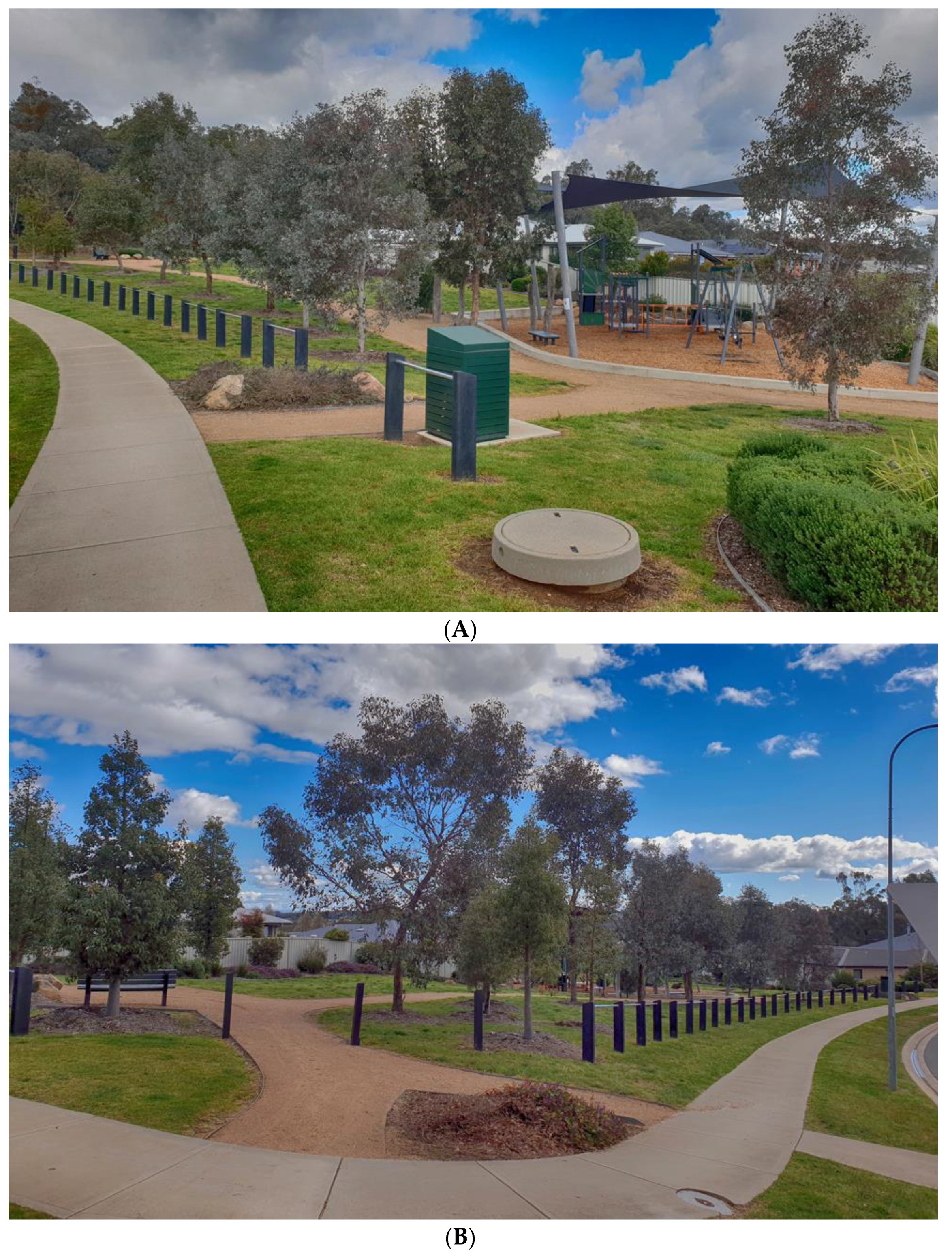
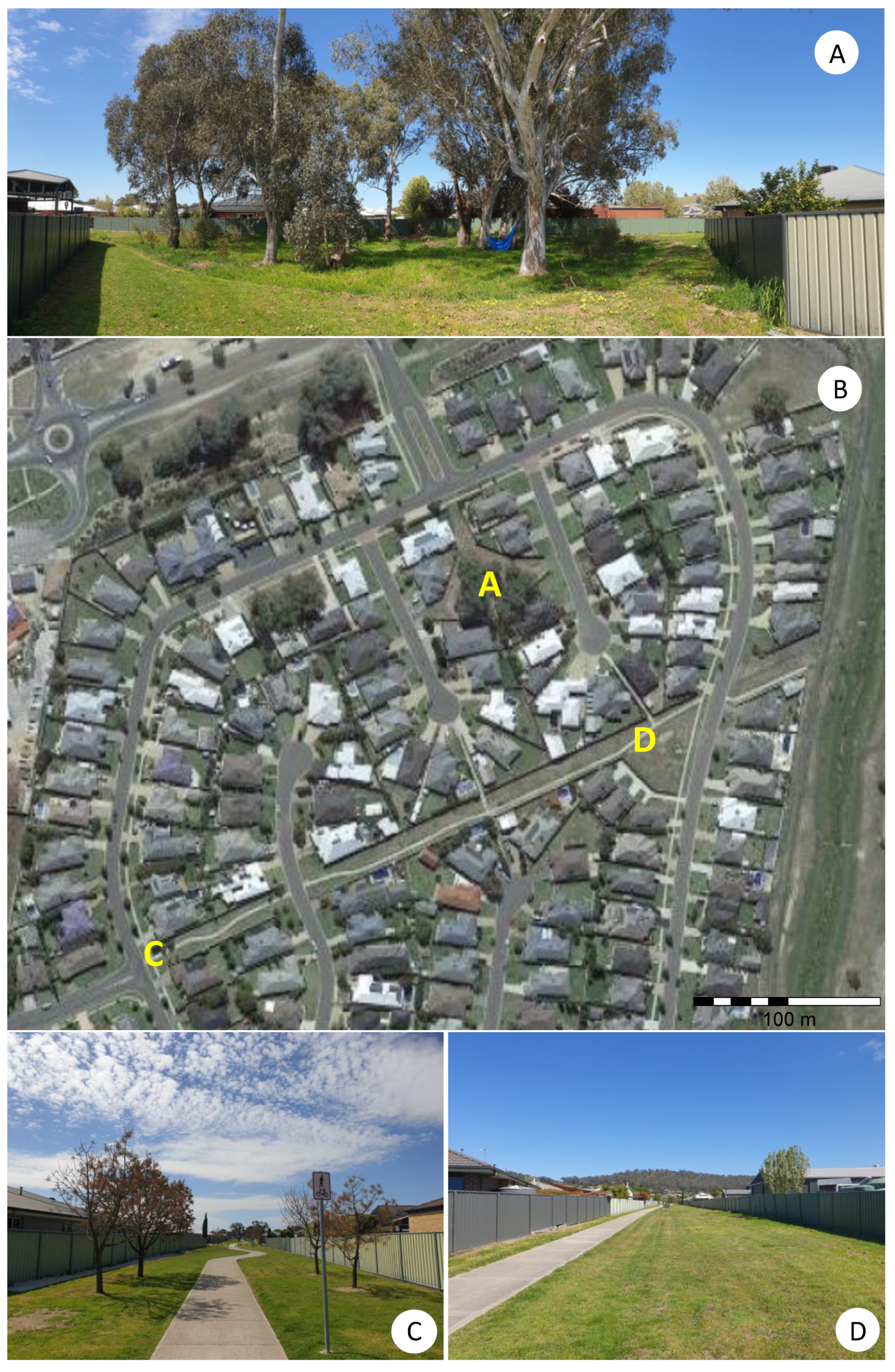
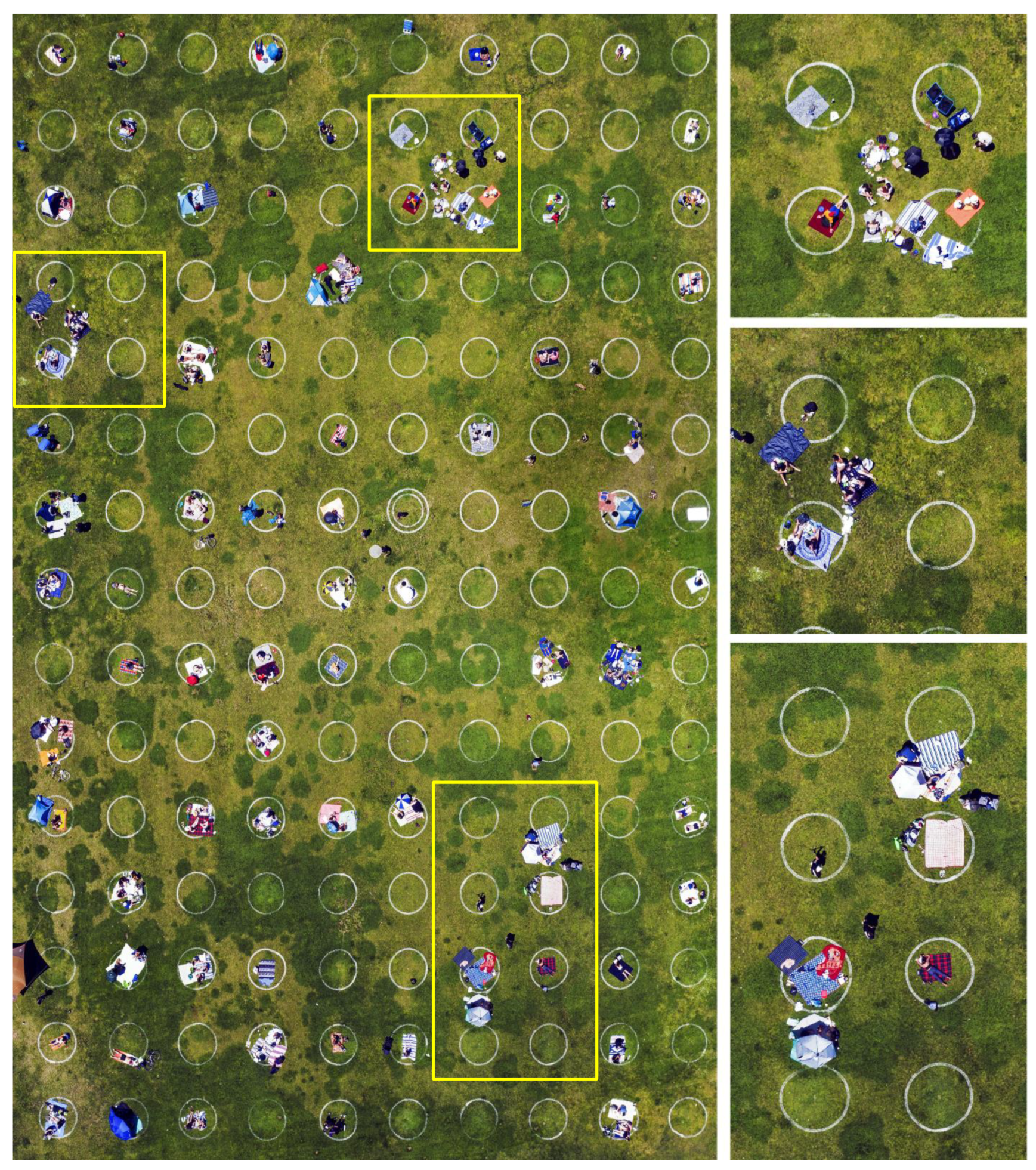

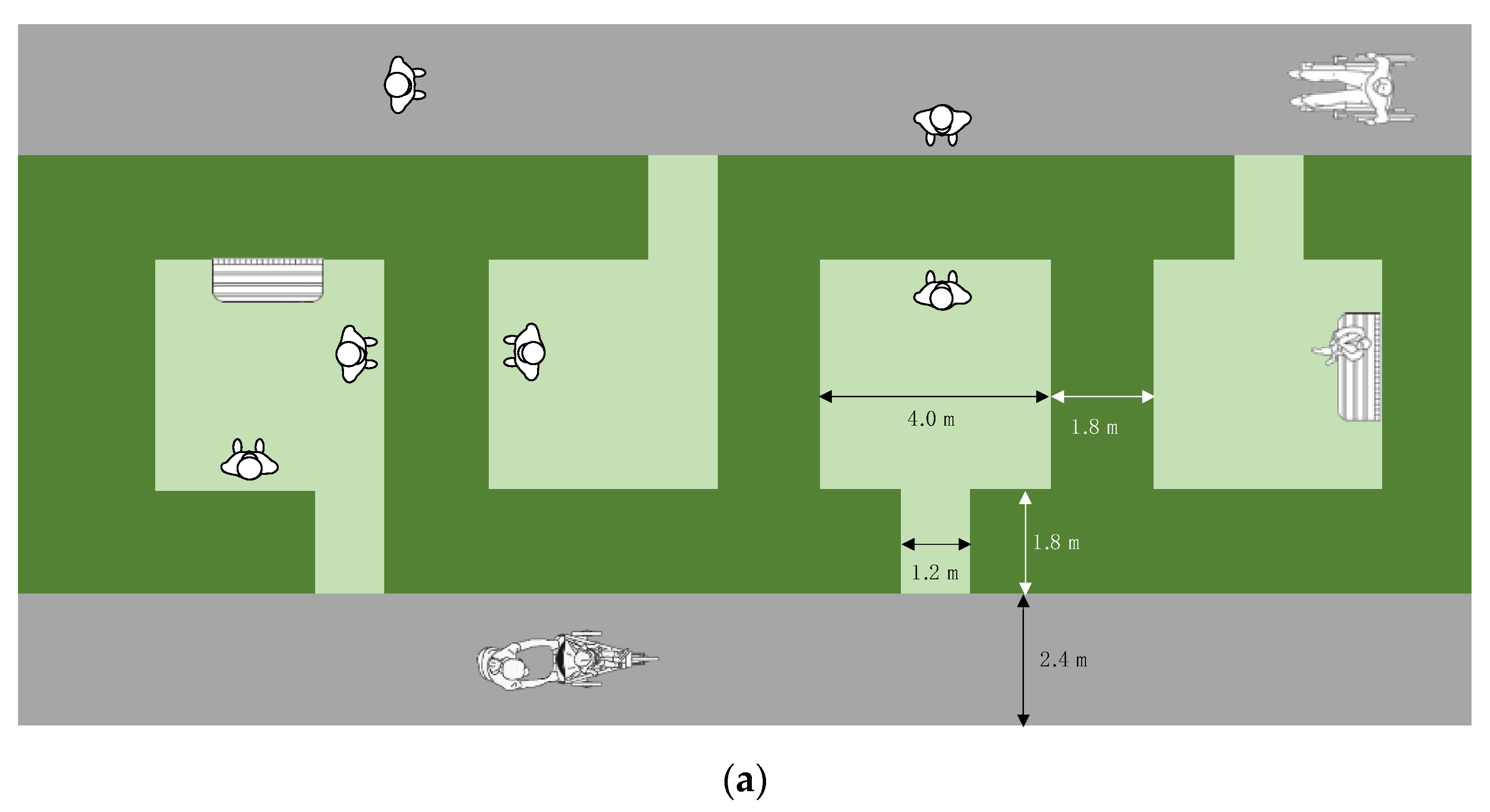
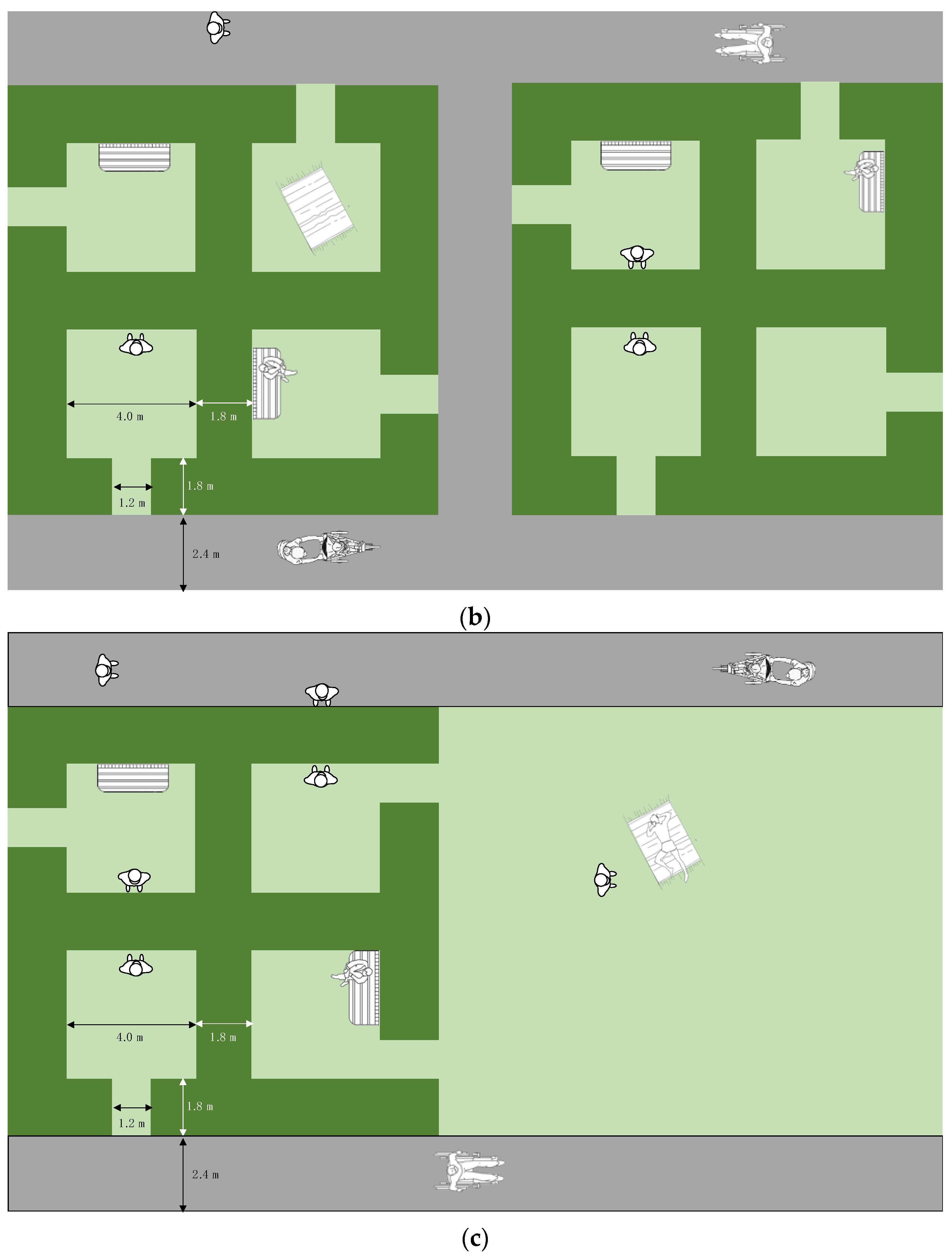



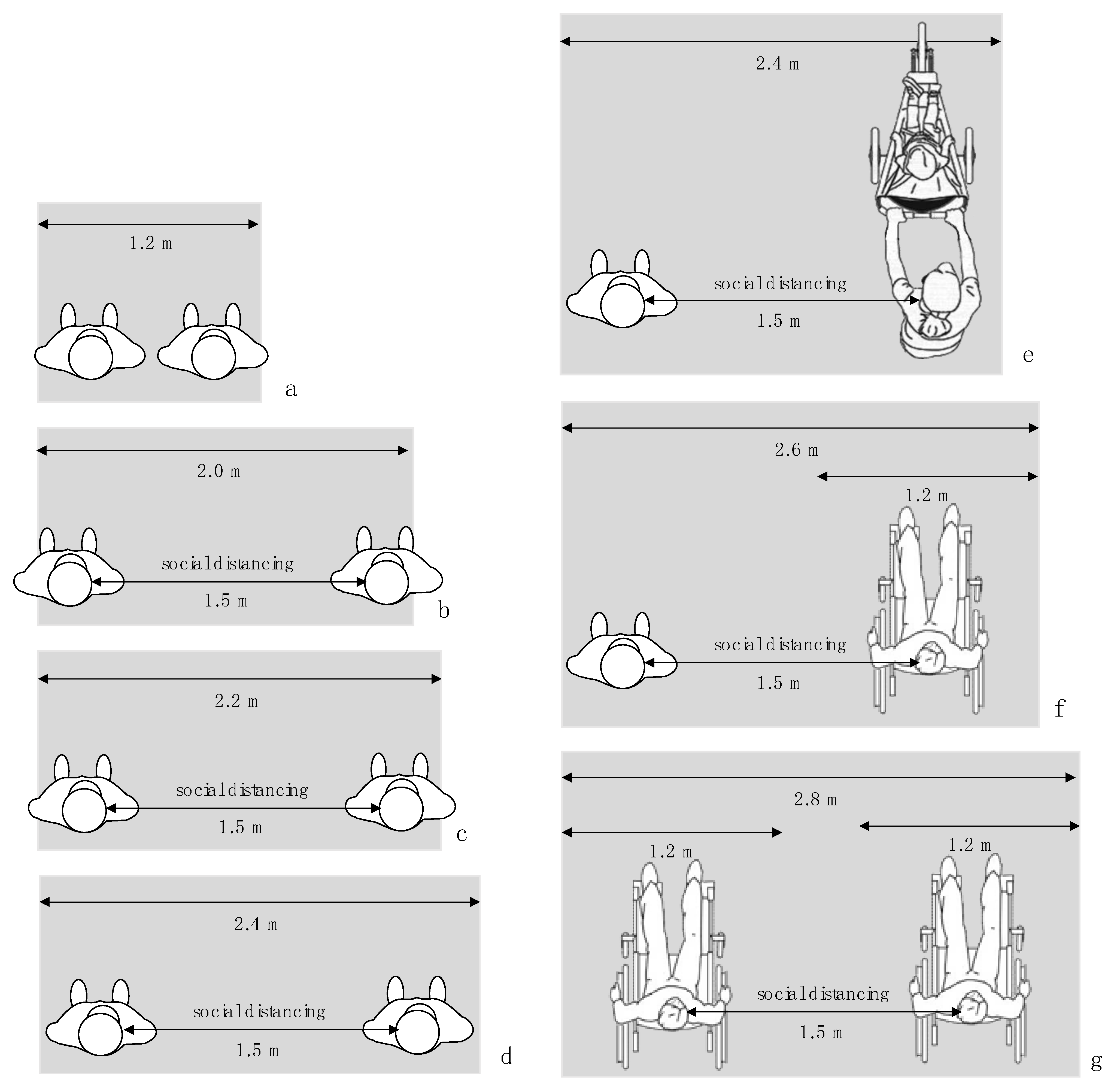
| Semi-Private | Public General | Public Specialist | |||||
|---|---|---|---|---|---|---|---|
| Apartment Complexes | Pocket Parks | Neighborhood Parks | Community Parks | Urban Parks | Botanic Gardens | Green Corridors | |
| area (range) (ha) | 0.0–0.2 | 0.1–1.0 | 0.5–4.0 | 2.5–10 | >10 | 0.5–4.0 | 0.0–1.0 |
| typical area (ha) | <0.1 | 0.1–0.2 | 2.0–3.0 | 4–6 | >8 | 2.0–3.0 | 0.1–0.2 |
| catchment radius (m) | 100 | 200–300 | 300–500 | 500–700 | ≥1000 | ≥1000 | 300–1000 |
| shape | rectangle | rectangle | rectangle | rectangle | rectangle | rectangle | linear |
| Social use function | |||||||
| Playground | (X) | (X) | X | X | X | ||
| picnic tables | X | X | X | X | X | ||
| rest spaces/benches | X | X | X | X | X | X | |
| Barbeques | (X) | X | X | X | |||
| running trails | X | X | X | X | |||
| bike paths | X | X | X | X | |||
| outdoor sport courts | X | X | X | ||||
| multi-use grass areas | X | X | X | ||||
| sport fields | X | X | X | ||||
| nature appreciation | X | X | X | X | |||
| community food | X | X | |||||
| group picnic spaces | X | X | |||||
| restrooms | X | X | X | ||||
| covered spaces | X | X | |||||
| event space | X | X | X | ||||
| public transit access | X | X | X | ||||
| Mental Health | Physical Health | |||
|---|---|---|---|---|
| Personal | Social | Low Level Exercise | High Level Exercise | |
| Private Garden | X | gardening | ||
| Condominium Garden | X | X | calisthenics | |
| Pocket Park | X | X | calisthenics | |
| Neighborhood/Community Garden | X | X | gardening | |
| Green Corridor | X | X | walking | running, cycling |
| Botanic Garden | X | X | walking | |
| Landscaped Parkland | X | X | walking | running |
| Remnant Bushland | X | X | walking | running, MBK |
| Riverine margin | X | X | walking, swimming | running |
| Coastal waterfront | X | X | walking | running |
| Beach | X | X | walking, swimming | running, swimming |
| Sporting field | X | X | walking | running |
| Peri-urban farmland | X | running, cycling | ||
Publisher’s Note: MDPI stays neutral with regard to jurisdictional claims in published maps and institutional affiliations. |
© 2021 by the author. Licensee MDPI, Basel, Switzerland. This article is an open access article distributed under the terms and conditions of the Creative Commons Attribution (CC BY) license (https://creativecommons.org/licenses/by/4.0/).
Share and Cite
Spennemann, D.H.R. Exercising under COVID-2x: Conceptualizing Future Green Spaces in Australia’s Neighborhoods. Urban Sci. 2021, 5, 93. https://doi.org/10.3390/urbansci5040093
Spennemann DHR. Exercising under COVID-2x: Conceptualizing Future Green Spaces in Australia’s Neighborhoods. Urban Science. 2021; 5(4):93. https://doi.org/10.3390/urbansci5040093
Chicago/Turabian StyleSpennemann, Dirk H. R. 2021. "Exercising under COVID-2x: Conceptualizing Future Green Spaces in Australia’s Neighborhoods" Urban Science 5, no. 4: 93. https://doi.org/10.3390/urbansci5040093
APA StyleSpennemann, D. H. R. (2021). Exercising under COVID-2x: Conceptualizing Future Green Spaces in Australia’s Neighborhoods. Urban Science, 5(4), 93. https://doi.org/10.3390/urbansci5040093






